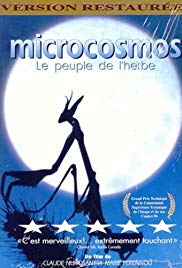MICROCOSMOS
Snippet Lesson Plan: Mosquito Emerging from Pupal Case
Subject: Science/Biology (Insects – Mosquitoes)
Ages: 10+; Elementary – High School
Length: Film Clip: 4 minutes; Lesson: 25 minutes.
This film is available from Amazon.com.
There is NO AI content on this website. All content on TeachWithMovies.org has been written by human beings.

Snippet Lesson Plan: Mosquito Emerging from Pupal Case
Subject: Science/Biology (Insects – Mosquitoes)
Ages: 10+; Elementary – High School
Length: Film Clip: 4 minutes; Lesson: 25 minutes.
This film is available from Amazon.com.
Using the Snippet in Class:
Students will be astounded at the beauty of this stage of a mosquito’s life cycle.
The interest generated by this snippet will make any class on insects, mosquitoes or disease vectors a memorable event.
This clip is a magnified slow motion clip of a mosquito emerging from its pupal sack on the surface of a pond.
1. Review the film clip and to make sure it is suitable for the class. Review the Lesson Plan and decide how to present it to the class, making any necessary modifications.
2. Retrieve from the Internet the photographs recommended below. Determine which are appropriate for the classes which will see the snippet.
TWM suggests that teachers build interest by allowing students to guess what is shown by this snippet. Start the snippet at the beginning of DVD Scene 12. Before the scene with the mosquito is reached, the class will see short segments showing a beetle, a grasshopper, and a praying mantis. When the segment showing the mosquito emerging from the surface of the pond is reached, ask students what they think it is. If they don’t guess what it is, tell them. Play the snippet again after students know what it shows. If you are going to provide students with any of the information in the Supplemental Materials, you can start while the snippet is showing the second time.
It might be a good idea to show students other short clips or photographs of mosquitoes at various stages of their life cycle. These might extend the lesson for a few minutes.
There are more than 2,500 different species of mosquitoes. These insects have spread over most of the world and they have been on earth for 30 million years. Adult mosquitoes have six legs, a pair of scaled wings, a pair of knobbed protrusions called halters, and a slender body. Most female mosquitoes suck blood from other animals. The male eats only fruit nectar.
The prey of female mosquitoes include: man; domesticated animals, such as cattle, goats, horses, and chickens; and wild mammals including deer, rabbit, birds, snakes, lizards, frogs, and toads. Some female mosquitoes prefer the blood of only one type of animal; others will feed on a variety of animals. Most female mosquitoes require a blood meal before they can lay their eggs.
The life span of an adult mosquito depends on several factors: temperature, humidity, sex of the mosquito and time of year. Most males live a very short time and usually die within a week after they hatch. Females usually live about a month. In most species, after the female mosquito lays a set of eggs, she will search for additional prey. She will lay another set of eggs only after she gets another blood meal.
The mosquito goes through a complete metamorphosis in its four stages of development: egg, larva, pupa, and adult. Eggs are usually deposited on the surface of water. The water can be of any quality, such as: melted snow, lake water, sewage effluent, or even mud. A tin can with a small amount of water in it can serve to hatch thousands of mosquitoes. Females of some species deposit eggs on moist surfaces, such as mud or fallen leaves, that may be near water. Months or years later rain or high tides moisten these surfaces and the eggs hatch into larvae. In hot summer months, larvae grow rapidly, become pupae, and emerge one week later as flying adult mosquitoes. Some spring species have only one generation per year. However, most species have many generations per year, and their numbers can rapidly increase over the summer.
Mosquito larvae live in water, eating algae and other plant materials. They breathe air through tubes that extend up to the surface. The pupal stage does not feed but unlike most insects, mosquito pupae are extremely active. The adult emerges from the pupal case using air pressure and lives the rest of its life on the land and in the air.
Mosquitoes are attracted to their prey by warmth, perspiration, body odor, carbon dioxide, and light. Female mosquitoes are the deadliest disease vector for mankind, infecting millions of people each year with illnesses such as malaria, sleeping sickness, and yellow fever. Mosquitoes are not the source of the diseases they carry; the females must first have a blood meal from an infected prey. The infection is spread to the mosquito’s prey in her next blood meal.
Mosquito-borne diseases have plagued civilization for thousands of years. In undeveloped tropical countries, they kill millions annually. Efforts to control mosquitoes in developed countries have greatly reduced the incidence of these diseases. However, in the United States mosquitoes still spread various types of encephalitis and the West Nile virus.
Why do mosquito bites itch and raise a welt on our skin? The swelling and itching come from an allergic reaction that people have to the saliva and anticoagulants that mosquitoes inject into our bodies when they bite.
This discussion adapted from various websites and parts paraphrased from U.S. Centers for Disease Control, Healthy Housing Reference Manual, Chapter 4.
This Snippet Lesson Plan was written by James Frieden. It was last revised on April 24, 2011.